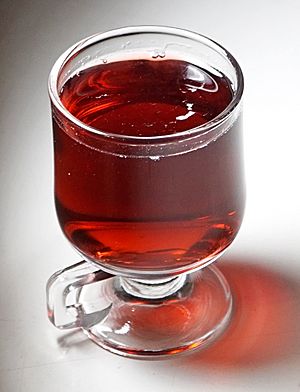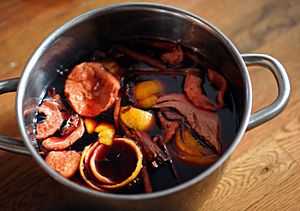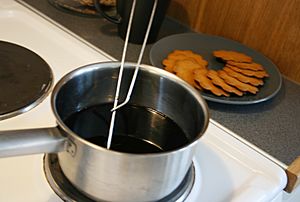Glögg facts for kids
Glögg (also spelled gløgg or glögi) is a special warm drink, often enjoyed in countries like Sweden, Norway, Denmark, Finland, and Iceland. It's a type of mulled wine or spirit that is spiced and usually served hot. People in Nordic countries traditionally drink it during the cold winter months, especially around Christmas time.
Contents
A Warm Drink for Winter
People in Nordic countries have been enjoying hot, spiced drinks for a very long time. Records show that warm wine was a common drink as far back as the 1500s. The first versions of glögg were spiced liquors. Messengers and postmen would drink them to stay warm while traveling on horseback or skis in the cold.
By the early 1800s, glögg became a popular winter drink for everyone. It was made by mixing and warming it with fruit juice, syrup, and sometimes a bit of stronger spirits.
How is Glögg Made?
There are many different ways to make glögg, and recipes can vary a lot! It often starts with white or sweet wine. Sometimes, stronger spirits like brandy or cognac are used.
One way to make glögg is to boil water and add spices to it. After simmering for a few minutes, the spiced water is strained. Then, fruit juice, wine, or clear spirits are added. Another method is to gently warm the wine, alcohol, and sugar (without boiling it). Spices are then left to soak in the mixture overnight.
The most common spices you'll find in glögg are cloves, cinnamon, cardamom, and ginger. Other ingredients often include citrus peels from oranges or lemons, raisins, or almonds.
Glögg Without Alcohol
Glögg can also be made without any alcohol. Instead of wine, people use fruit or berry juices. In shops, ready-made glögg often uses grape juice. Sometimes it's made with blackcurrant juice, mixed fruit juice, or apple juice.
Ready-made glögg from shops needs to be warmed up before you drink it. If it contains wine or a lot of alcohol, it's important not to heat it until it boils. It's a common tradition to add whole almonds or raisins to your glögg just before you drink it, or while it's warming up.
Glögg's Journey to Finland and Estonia
Glögg first came to Finland from Sweden. The Finnish word glögi comes from the Swedish word glögg. This word originally came from glödgat vin, which means "hot wine."
At the end of the 1800s, glögg almost disappeared in Finland. This was because of a time called prohibition, when alcoholic drinks were not allowed. When this rule was lifted in the 1930s, glögg started to be advertised again in magazines for people who spoke Swedish in Finland. By the 1950s and 1960s, drinking glögg was a special tradition for them.
In the late 1960s and early 1970s, glögg recipes began to appear in Finnish language magazines too. After that, glögg became a popular Christmas tradition for everyone in Finland.
In Estonia, people had known about mulled wine for a long time. But the Swedish-style glögg only became popular in the 1990s. This was after Estonia became open to outside influences following the end of the Soviet Union. Local companies in Estonia started making glögg in 1995.
See also




